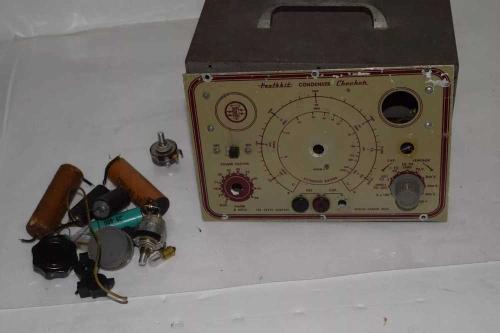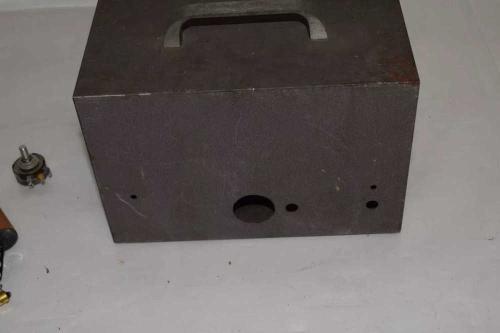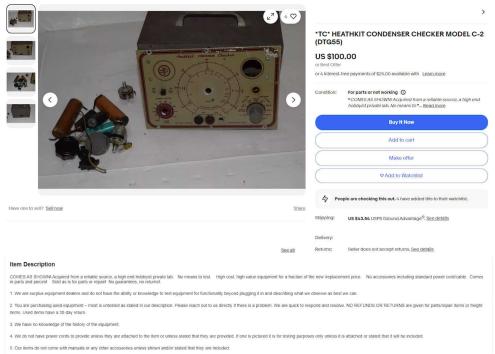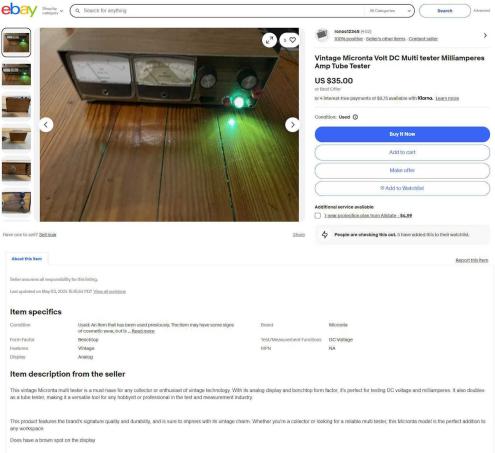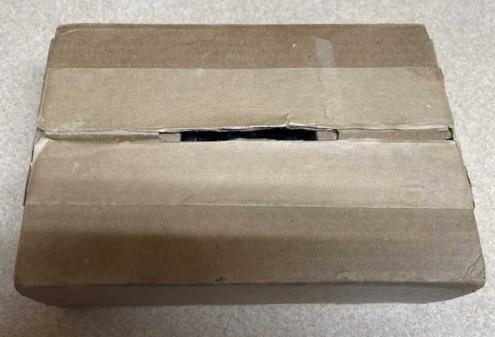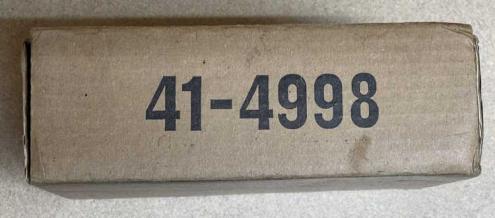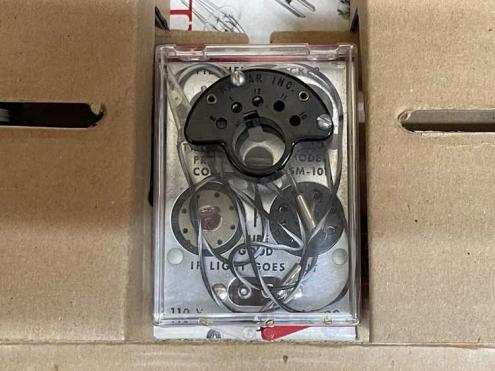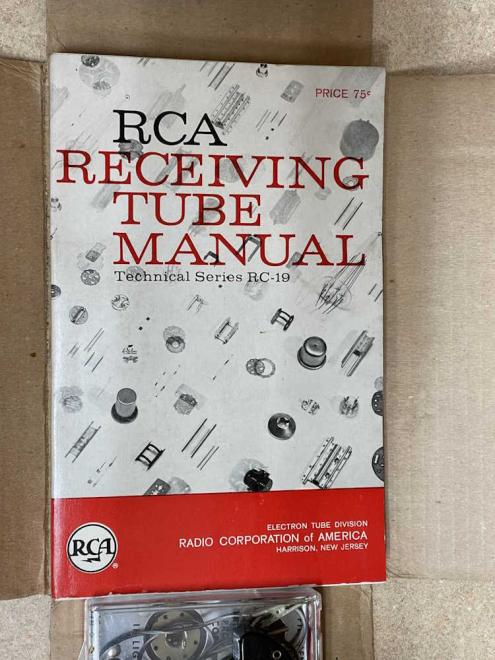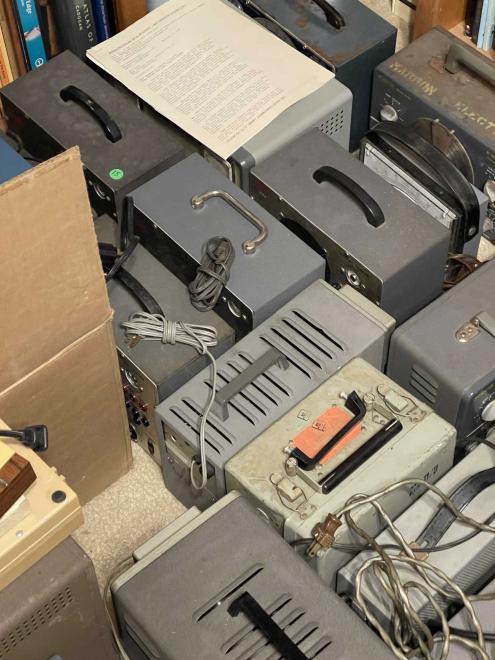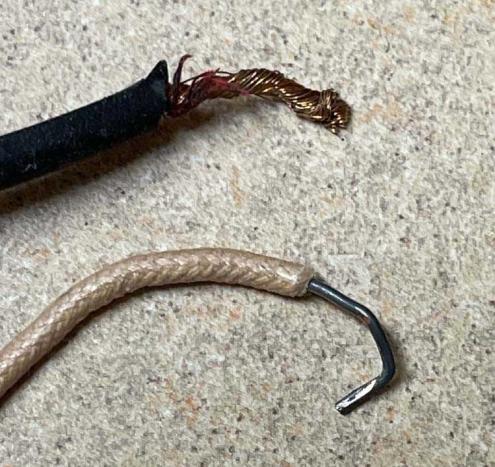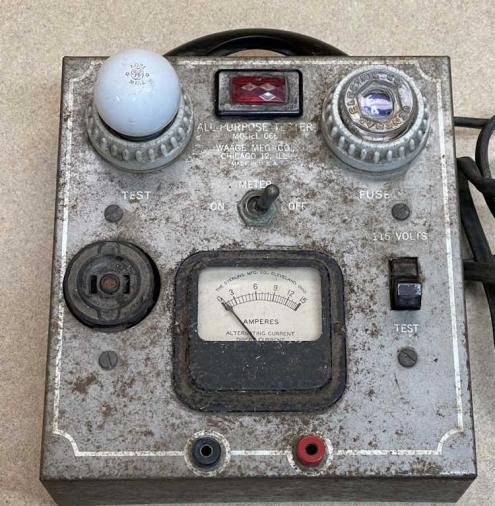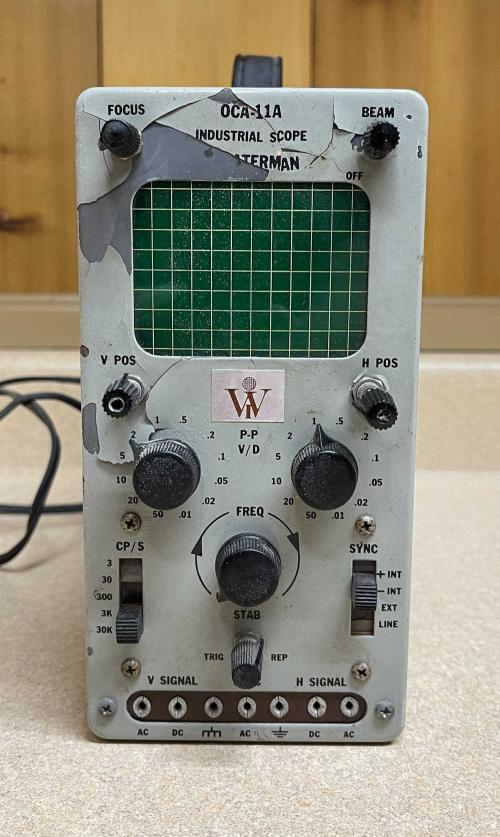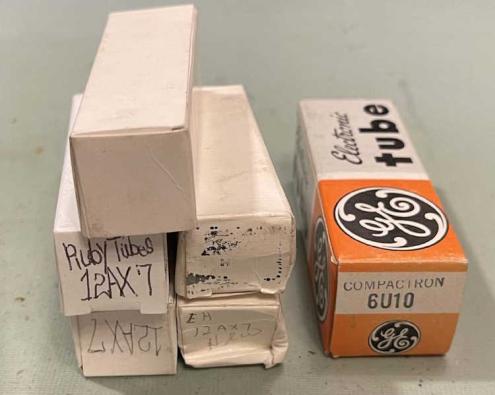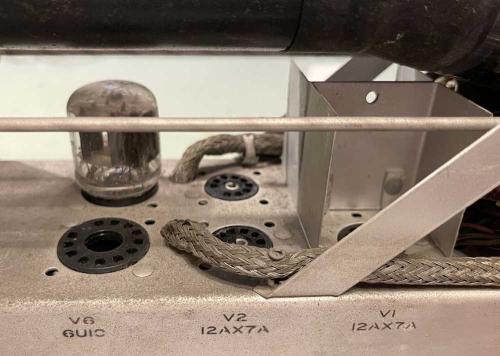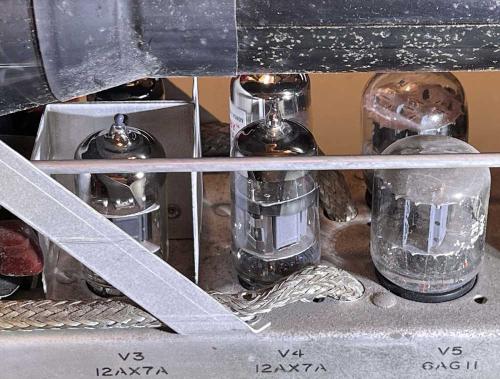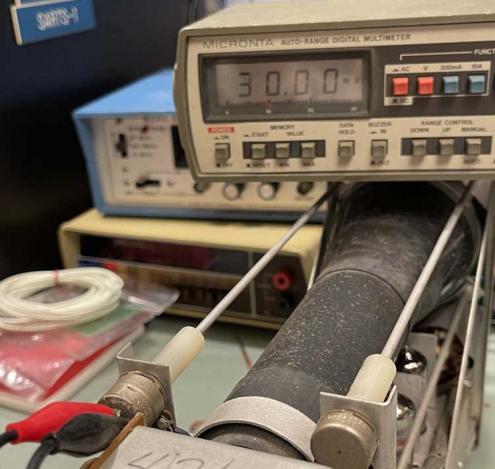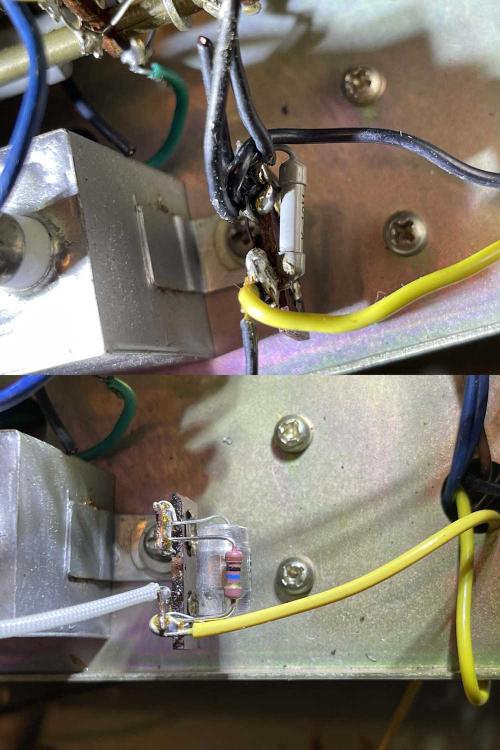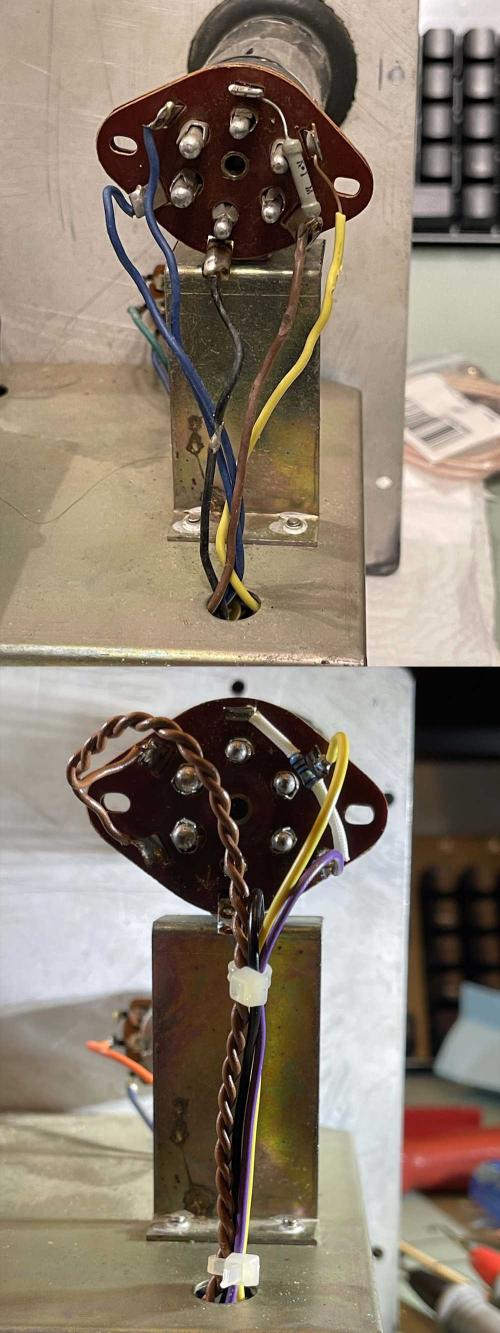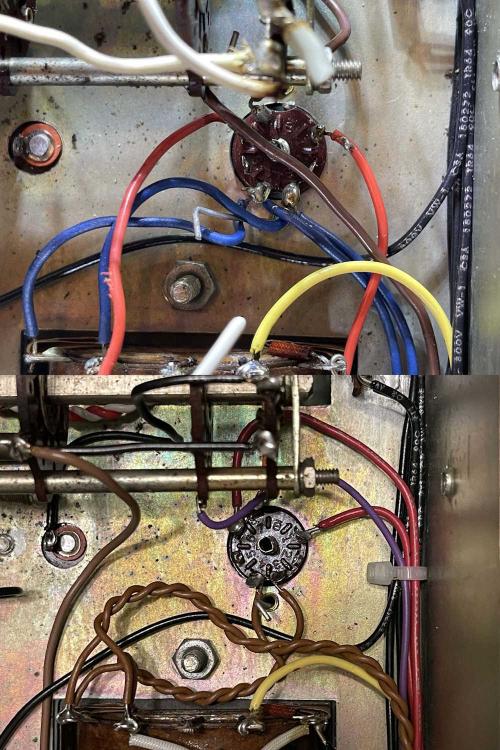- 2025
- May
- 14
Crap from eBay #2 - “High cost, high value”
Here’s a Heathkit C-2 “Condenser Analyzer” for sale. It’s listed at $100 with almost $44 in shipping.
For some reason, capacitor analyzers of this nature have become the hot thing. It’s in part due to the glowing green magic eye tube that these used as their primary output display indicator, but also (I’ve been told) people use these and their high-voltage outputs to “reform” old capacitors for reuse. Why? I guess because the Internet told them that old=good, new=garbage.
You’ll notice this thing is in fairly poor condition. It has a pile of parts included with it. Some of them obviously came from the device. Some did not. All of them had to be cut out of circuit in order to be in this pile. It looks like someone just grabbed a handful of things nearby and added them to the image.
These devices were a very simplistic variant of the capacitor checker, and had a small chassis at the top that contained the power and eye tube circuitry. It appears to still be there by the screws in the panel, but that’s about it. The eye tube is missing. Two of the three controls are missing (are they in the pile?) The leakage lamp is gone, and the panel is, overall, in poor condition. We can’t see the chassis itself anywhere so there’s no guarantees that anything other than the metal is still there. Even that is suspect!
The front panel is in poor condition, but the case is in just as bad of condition. It’s intact, but rusty. The handle is still there, which is good, but that’s about it. No power cord is present, so it’s probably been cut off for some reason.
If I were to see this at a hamfest, it would probably be in the dollar box, or even the “free” box. I’d take it for a buck to get the aluminum handle and knob and dump the rest in the trash on the way out. This, in my opinion, is certainly not $144.00 worth of anything.
The good part is the description:
There’s our images again. You can plainly see they aren’t showing a chassis here, even though all of the screws are missing and it would be easy to do so. Why not? Why show the pile of parts close up but not the chassis?
But as stated, the description is pure gold.
“Acquired from a reliable source.” What’s that supposed to mean?
A “High end hobbyist private lab.” If this is the case, then this was in their junk bin.
“No means to test.” No kidding. Really? The exploded view is laying on the bench, exploded.
“High cost, high value equipment for a fraction of the new/replacement price.” Again, what is this supposed to mean? I can get a brand new device that does everything but leakage for $25, with the added bonus of testing every other common part as well.
(Leakage is not necessarily as useful as it seems. These devices were designed to test paper, mica, and electrolytics of the 1940s-1960s. Chances are, all of those old paper and electrolytics are bad and will get replaced regardless, so who cares if they leak? They need to be replaced.)
Much of this listing is boilerplate from the seller, and they use it in all listings. But some of it, in my opinion, is deliberately playing on a potential buyer’s desire to own one of these, even if they don’t fully understand the device. While I have no problem with selling this device itself (I used to sell used and parts-only things on eBay years ago) this device is (again, my opinion only!) being deliberately puffed up in order to make it appear it’s something it’s not. I don’t know if this is malicious or if it’s just the seller’s lack of knowledge - but with the other things seller has listed I think I’d be well within rights to assume they have some knowledge of this device.
Of course, it’s buyer beware on eBay, but still. Treat your customers with a little respect here. You got junk, sell it at a junk price!
If you do want one of these, there are several examples of the better C-3 device available, for substantially less than this one. Many of those are demonstrated working.
This one is here because the seller seems to be playing on the desire for this kind of device, even though the example they have will probably never be operational again.
Buyer beware!
- 2025
- May
- 6
Crap from eBay #1 - “Doubles as a tube tester!”
(This was called AI Crap…but I decided there’s so much normal crap on eBay that I should rename the series!)
eBay was both a bane and a boon to the electronics world. A boon because it allowed more people to sell off equipment and and materiel (that they may not have had a venue for) to a wider audience, but a bane because it took some of those things out of the hamfest market and put them up for a much higher price. While I don’t blame people for trying to get more money out of stuff, prices on eBay can be insane.
To add to the crazy, people who have zero knowledge of what they are selling now have AI available to write them a description instead of a “Says XXXX, no idea how to test.” AI, invariably, is wrong about this stuff because no one is using this antique stuff to do what it says it does. It gives sellers a false sense of what the device does and what it’s used for, and invariably feeds the “tubes = money” attitude that the layman has. Just because it has vacuum tubes in it doesn’t mean that it’s valuable, useful, or even interesting.
This is the first in a not-often series of wacky stuff I see on eBay. This one is a “Vintage Micronta Volt DC Multi tester Milliamperes Amp Tube Tester.”
It’s obviously someone’s homebrew power supply with Micronta (Radio Shack) meters on the front. Case would date it to the 70s, most likely.
AI has written a lovely line of BS for this device:
“This vintage Micronta multi tester is a must-have for any collector or enthusiast of vintage technology. With its analog display and benchtop form factor, it’s perfect for testing DC voltage and milliamperes. It also doubles as a tube tester, making it a versatile tool for any hobbyist or professional in the test and measurement industry.
This product features the brand’s signature quality and durability, and is sure to impress with its vintage charm. Whether you’re a collector or looking for a reliable multi tester, this Micronta model is the perfect addition to any workspace.”
I’m not sure how a power supply tests DC voltage, or even how you test a milliamp. Do you give it a quiz? If you have one joule per coulomb, how many volts is that?
It then goes on to say that it doubles as a tube tester. While I guess you could technically test the filaments of a tube with this, it’s nothing of the sort - any power source will do that for you, assuming it’s the correct voltage.
And then there’s the standard boilerplate that let’s you know AI wrote this, that of how it features the brand’s quality and reliability even though someone built this from their junk box - the only thing missing is how it’s widely used in the industry. It tried, though, with the “if you’re looking for a reliable multi tester…”
I got a giggle out of this one, not because of what it is, but of how it’s being described. It’s been for sale for some time, I don’t expect it to go anywhere soon.
- 2025
- Apr
- 28
A Tricraft Products Corp SM-101 Filament Checker
I picked this little gadget up at the ACARA hamfest. Not because I plan on using it, but because it’s an unusual little thing and had a brand new book with it.
It’s a rather unassuming box with a number on the side.
What’s inside is this little gadget, a power cord, and a book. The gadget:
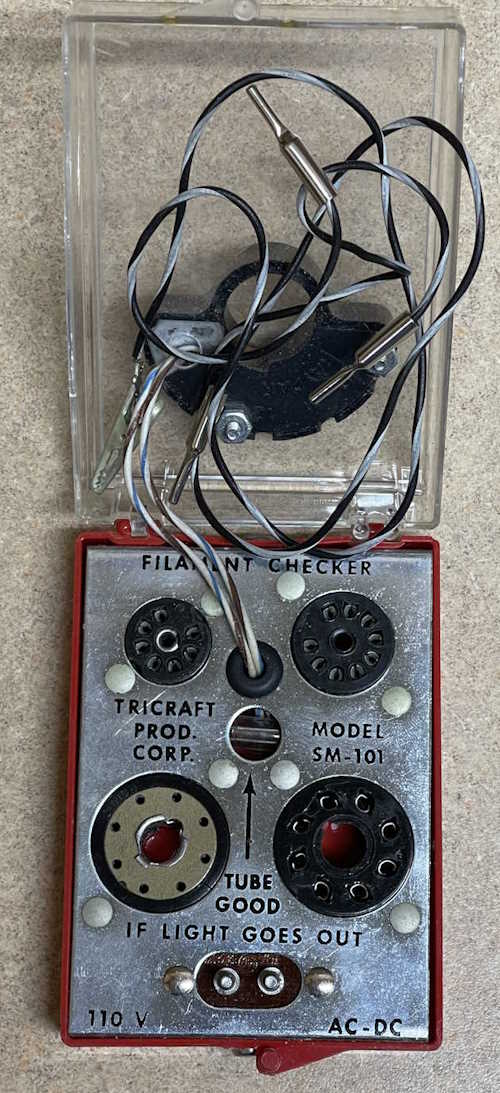
It claims to be a Tricraft Products Corp SM-101 Filament Checker. I’m not sure how it works because there’s no instructions for the device. It appears to be used, but only very little. I can see some wiping on the contacts. The power cord was unrolled and rolled back up with bread ties.
I can’t imagine this was terribly useful, your VOM would have been quicker than getting out a power cord and plugging all kinds of little pins together in an attempt see if the filament was good.
The real gem is the book. The RCA Tube Manual RC-19 from 1959. It appears to be unused, if a little dirty.
That’s worth the few dollars I paid for it right there. The other piece? A cool gimmick gadget for display.
- 2025
- Mar
- 13
The Linksys WML11B media player - it’s time to say goodbye.
A few years ago, I wrote a piece detailing some fun I had with a Hamvention find, an ancient Linksys WML11B media player. You can find that article right here.
This is a device from the very beginnings of the Consumer Internet Age, and is evidenced by it’s early Wireless-B connectivity. Fortunately, it also offers an Ethernet connection. But…that’s about it. Modern browsers refuse to communicate properly with this thing’s web interface, seeing as how it was designed to be used with IE6. Modern HTTPS audio streams don’t work here because HTTPS was just starting to show up in the consumer space when this was made.
The weirdest thing is that a gigabit Ethernet port, which is usually more than capable of negotiating downward, doesn’t work well with this device. The device will simply stop playing and claim it has no connection after a short period, usually around an hour. A 100base connection will play for hours until the relatively fragile buffering in this device hits a hiccup and it stops.
That’s a real shame too, because this is actually a pretty good sounding device, probably on par with the Squeezebox Boom that came much later. What’s also a shame is, while this did have a now long-gone backend that would feed it station lists, it also had it’s own internal presets. You could use this thing and not have to worry about someone pulling a Reciva on you.
Seeing as how those squeezebox devices are still viable due to the continuation of the media server by Lyrion, I’ve decided to replace this unit with a used Squeezebox Radio that I purchased online for cheap. I’m not sure what to do with it, but the amplified speakers could be useful since they’re of decent size and good sound quality.
Who knows…you may see it at a hamfest near you!

- 2025
- Jan
- 22
What do you mean I have a problem?
I don’t have a problem.
Well, maybe I do have a little bit of a problem. But they all work. They’re just waiting…for…something. Yes, that’s it.
- 2025
- Jan
- 18
I guess the wire was supposed to be the fuse?
Here’s some wire from the appliance test box I posted about a few days ago. One piece is the line cord, the other some of the internal wiring.
I should mention that this box was rated for 15 amps AC.
The black one is the power cord. It’s nice, heavy, stranded red copper. The closth-covered one? Nah, bro. That’s 18GA and is rated for 14A. Other wire in the box was 18GA PVC coated, and certainly would have started smelling a little funny had you ran this device at max capacity - indeed, that metal toggle on the front had a terminal where the solder had melted away and it was just hanging on by a thread. Something in there had been hot for a long time.
I had made a joke about self-fused wire and a portable house fire in waiting on LinkedIn, but it didn’t go over well. People were getting very upset over it and I decided that was something not appropriate for the audience there. I guess my sense of humor is just strange.
Regardless, this thing wasn’t anywhere near rated for it’s nameplate capacity. I’m really surprised there wasn’t more heat damage evidence on the various connections. All of that old stuff has been removed and discarded, the only thing that will be in use is one of the ceramic sockets and a new meter that I’ll install before use.
The post about the device itself: https://wereboar.com … -waage-066-test-box/
- 2025
- Jan
- 17
What to do with this thing? The Waage 066 test box…
Some time ago I posted about this device that I picked up at the Butler Hamfest. It’s a dim-bulb tester designed for appliance service - Waage made (and still makes) resistive heating element devices, so something like this would be right in line with their products - assuming you didn’t burn the small gauge wire inside the thing up!
(Dim bulb testing means having a lightbulb in series with the device you’re working on - if the device is shorted, the lamp will absorb the voltage, preventing damage to your device, It’s a common tactic in working with old radio and television devices where you could destroy an unobtainable part if something is shorted.)
Since it’s not really of much use to anyone as-is, I think I’m going to try and repurpose this into some sort of display piece. I’ll try and find a voltmeter that will fit the hole, fix the pilot lamp, and place a low-wattage bulb in the one socket. Make it into an accent lamp of sorts.
I think that’s probably the best use for this, as I hate to see it scrapped. Stay tuned, hamfests are starting up for the year and I’ll be on the lookout for a meter.
- 2024
- Dec
- 15
A Waterman OCA-11A “industrial / pocket” oscilloscope - Part 2: Tubes!
I picked this device up at the MARC hamfest in North Canton. The seller stated “Someone removed all the tubes except one” and he was right. 4 12AX7 and 1 6U10 were required to fill all of the sockets again.
This is the device in question. It looks like it requires both a horizontal and vertical input, but I’m not sure.
Thanks to Bob @ hamtubes.com, I was able to acquire the necessary tubes. I’m not sure why they were removed, they aren’t really that much unless you want old RCA branded 12AX7. The 6U10 compactron isn’t expensive at all. I chose Russian and Chinese 12AX7 because this is an instrument, not an amplifier.
A little bit about one of these tubes: the 6U10 “”compactron” was the last gasp of the tube industry. Packing up to 4 devices in a single shell, this was an attempt by GE to reduce the number of tubes required for a television set. Had these come out before the transistor era started, we might have seen more elements in a single tube, but we didn’t, and the rest is history. This particular device contains 3 triodes - probably why it was removed by the previous owner.
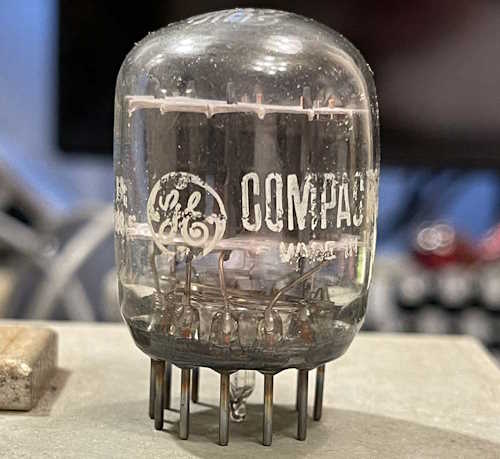
So let’s open it up and populate things. Indeed, it is empty in here:
And now it’s full:
Some of these tubes were hard to get in to their respective sockets.
I did notice the one remaining tube was Waterman branded. That’s too bad, the others probably were too. I wonder who made these - maybe I’ll pull it out sometime and see if it has an EIA code on it.
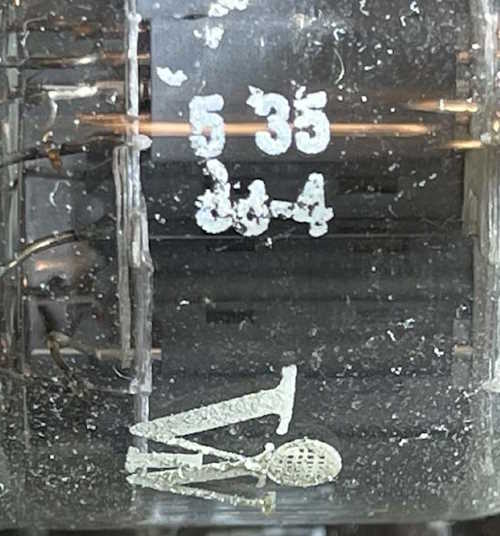
Ok, so…let’s try it. Checking across the line cord I get…nothing. Mmmmm that’s not good. No external fuses, so what’s wrong here. Start with the line cord, it goes to the fuse, then to the switch, then to the ….nothing.
Power switch is bad. It’s pretty corroded, so no surprise. Well, I’m out of time for this particular device at the moment, so a note and set it aside. Stay tuned for the next part where we turn it on for reals!
Next part of this series: https://wereboar.com … oscope-part-3-final/
Previous part of this series: https://wereboar.com … pocket-oscilloscope/
One more part on this one…I believe it to have an unrecoverable fault…
- 2024
- Dec
- 13
Tales from the eBay universe.
For the most part, the stuff I see on eBay that I like is reasonably priced. Some is excellent, some is “Let me offer you a little less”
There there’s this one. Maybe the person doesn’t know what they are offering, or maybe they think because it’s “old” that it’s valuable beyond compare. Who knows, but this thing looks like B.O.B. from the Black Hole. I can’t really tell what’s happened to it beyond it’s Seen Some Stuff. Bent cabinet, bent control shafts, but surprisingly it still works. This is a $5 hamfest “Please take me” sale.
$250? Maybe if it was still in the box, and the box wasn’t opened.
- 2024
- Dec
- 11
An Olson TE-189 C-R Analyzer - Rebuild, part 2 - I only wanted to replace some capacitors.
After digging in to this unit, I determined that it was a basket case. While the unit itself wasn’t baked, the builder most certainly was. Probably less than 1 out of 5 wires in this thing (that weren’t bare interconnects on switches) was soldered securely. The rest? Bad or no solders, wires pulling out of their terminal, no wetting, too much solder, blobs everywhere. Burnt wires, solder drips…you name it. This thing was a how to on how to not solder. I realized that if I wanted to see this thing work reliably, it was going to be a partial rewire.
Here are some before and after shots of the cleanup crew’s work:
First is part of the drive for the eye tube. This consists of a capacitor coming in from the terminals on the front, a 1500pF capacitor, and a 10MΩ resistor on a terminal strip…with lots and lots of grounds attempting to terminate here as well.
All of the grounds were removed and single-pointed back to the other side of the chassis. The old parts were replaced with new, high quality parts - the input capacitor went from one of those leaky metal can Japanese parts to a new film cap, the 1500pF ceramic disk (with half it’s coating missing) is now a 600V polystyrene, and the resistor is just a good metal film part. The terminal is now clean with a single wire leading to it. Unfortunately, since the screw for this also holds the 4μF capacitor, I couldn’t solder it down, but it’s tight and clean.
Next is the socket for the eye tube. Almost every wire is burnt in some place, be it here or below the chassis. The black wire is j-hooked together, and the yellow wire has far more exposed copper than is safe. Even the 1MΩ resistor is poorly placed, having too much lead on one side and a “Oops, I cut it too short” lead on the other. Here it was just rewiring everything with fresh wire and properly twisting the filament leads. The resistor now lays in the socket with the proper spaghetti coating.
Last is the tube socket for the power supply. This has quite a bit of voltage on it, so it needed cleaned up. Twisted filaments, and fresh wire leading directly out of the socket fixed this one. I admit that the copper is a bit too much, but I’m happy with the results overall. The previous build had some solder balls here, and the fialments were all terminating to this point. I’ll brush this down to get the flux off before final inspection.
Prety much everything except for a couple pieces of coated wire and a couple of capacitors that are still good have been or are being replaced, including the big 500Ω balancing resistor that was flopping around the transformer. Even the AC has been moved off to it’s own isolated terminal strip for ease of disconnect in case of trouble.
I’m waiting on some Blue wire for the measurement section of the device (I’ve tried to keep the original color scheme as much as possible) so hopefully this will be done in a week or so. Stay tuned for the final part of the build, coming soon!
Next part of this series: https://wereboar.com … er-the-waiting-game/
Previous part of this series: https://wereboar.com … -intermission-parts/
